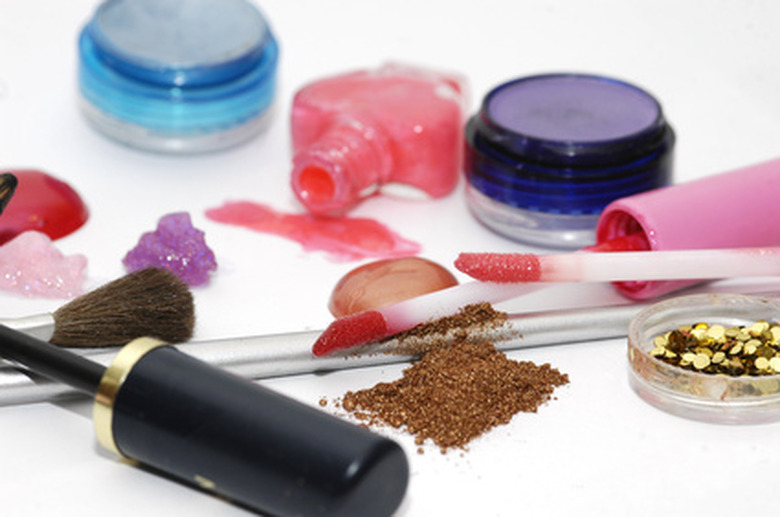Makeup & Science Fair Ideas
After your third papier-mâché volcano or soda bottle rocket, it may be time to liven up your science fair with a creative project that examines the powders, gels and creams that line your medicine cabinets. Cosmetics are common household items that transform into fascinating experiment specimens with a few simple tools and a bit of creative thinking. From product testing to ingredient comparisons, cosmetics provide a range of opportunities for science fair projects.
Psychological Science of Makeup
Psychological Science of Makeup
Scientific explorations involving makeup are not limited to the biological and chemical sciences; the psychology of makeup is well-documented and the subject of many social science investigations and experiments. A 1980 study by researchers Jean Ann Graham of the University of Pennsylvania and A.J. Jouhar of Bristol-Myers Co. concluded that proper makeup application results in wearers being perceived as more physically attractive and therefore more desirable, personable and even intelligent.
Consider a live demonstration in which fair-goers are asked to rate the attractiveness, likability or intelligence of two images of the same person in which one image includes makeup and the other does not. Compare the ratings of your experiment with the findings of other experiments involving cosmetics and beauty.
A longer-term project may involve asking several fellow students who regularly use makeup to keep a journal of their experiences for one week without wearing makeup. Design your science fair poster in a way that highlights similarities between test subjects with regard to their feelings or anxieties about being without cosmetics.
Makeup and Bacteria
Makeup and Bacteria
Many cosmetic products claim to resist the growth of bacteria or other harmful organisms, but the expiration dates on cosmetic products are there for a reason. Consistent application of makeup introduces bacteria and germs to the applicators and the makeup itself, especially if you apply it with your hands and then touch the product again.
Conduct an experiment in which you examine several makeup samples under a microscope to investigate the presence of bacteria. You may opt to raid your own cosmetic stash for samples, or you can devise a comparison observation in which you test swabs of expired makeup with swabs of new makeup.
For an interactive demonstration, invite fair guests or judges to go through their bags and examine swabs of their own products under a microscope you've set up. Be ready with a list of common bacterias to help them identify the specimens on their makeup products.
Testing Product Claims
Testing Product Claims
Cosmetic products are labeled with a range of buzz-words designed to persuade consumers to purchase one brand over the other. Although the Food and Drug Administration regulates the inclusion of demonstrably harmful chemicals in cosmetic products, manufacturers are still free to label items as "long-lasting," "all natural" or even "hypoallergenic" without strict FDA oversight. Devise a science project in which you test the claims of several cosmetic products. For example, apply two lip stains that each claim to be long-lasting to each half of your mouth and document the fading over the course of the day.
Many shampoos or conditioners claim to strengthen hair; test their claims by removing small lengths of your own hair and testing its strength by holding them while a partner suspends weights by a piece of string to the other end. Then wash the pieces in several brands per the package instructions and repeat the strength test.
References
- Science Buddies: Science Fair Project Question
- Super-Science-Fair-Projects.com: Science Fair Project Cosmetic Ideas
- Daily Mail: Women warned of make-up bacteria risk as the average cosmetics bag is found to be four years out of date
- International Journal of Cosmetic Science: Cosmetics Considered in the Concept of Physical Attractiveness; Jean Ann Graham and A.J. Jouhar; 1980
- U.S. Food and Drug Administration: Guidance, Compliance and Regulatory Information
Cite This Article
MLA
Wahlig, Hannah. "Makeup & Science Fair Ideas" sciencing.com, https://www.sciencing.com/makeup-science-fair-ideas-12745492/. 12 September 2010.
APA
Wahlig, Hannah. (2010, September 12). Makeup & Science Fair Ideas. sciencing.com. Retrieved from https://www.sciencing.com/makeup-science-fair-ideas-12745492/
Chicago
Wahlig, Hannah. Makeup & Science Fair Ideas last modified August 30, 2022. https://www.sciencing.com/makeup-science-fair-ideas-12745492/
